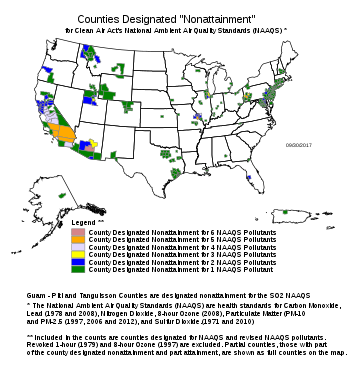
The U.S. National Ambient Air Quality Standards (NAAQS, pronounced /ˈnæks/ naks) are limits on atmospheric concentration of six pollutants that cause smog, acid rain, and other health hazards.[1] Established by the United States Environmental Protection Agency (EPA) under authority of the Clean Air Act (42 U.S.C. 7401 et seq.), NAAQS is applied for outdoor air throughout the country.[2]
The six criteria air pollutants (CAP), or criteria pollutants, for which limits are set in the NAAQS are ozone (O3), atmospheric particulate matter (PM2.5/PM10), lead (Pb), carbon monoxide (CO), sulfur oxides (SOx), and nitrogen oxides (NOx).[3] These are typically emitted from many sources in industry, mining, transportation, electricity generation and agriculture. In many cases they are the products of the combustion of fossil fuels or industrial processes.[4]
The National Emissions Standards for Hazardous Air Pollutants cover many other chemicals, and require the maximum achievable reduction that the EPA determines is feasible.
- ^ "Definition of National Ambient Air Quality Standards (NAAQS)". ohioepa.custhelp.com. Retrieved 2018-03-29.
- ^ "Trans-Alaska Pipeline System Renewal Environmental Impact Statement article". Archived from the original on 2017-10-20. Retrieved 2009-10-12.
- ^ EPA, OAR, US (9 April 2014). "Criteria Air Pollutants | US EPA". US EPA. Retrieved 2018-01-18.
- ^ Factsheet des.nh.gov Archived 2020-02-29 at the Wayback Machine
© MMXXIII Rich X Search. We shall prevail. All rights reserved. Rich X Search
